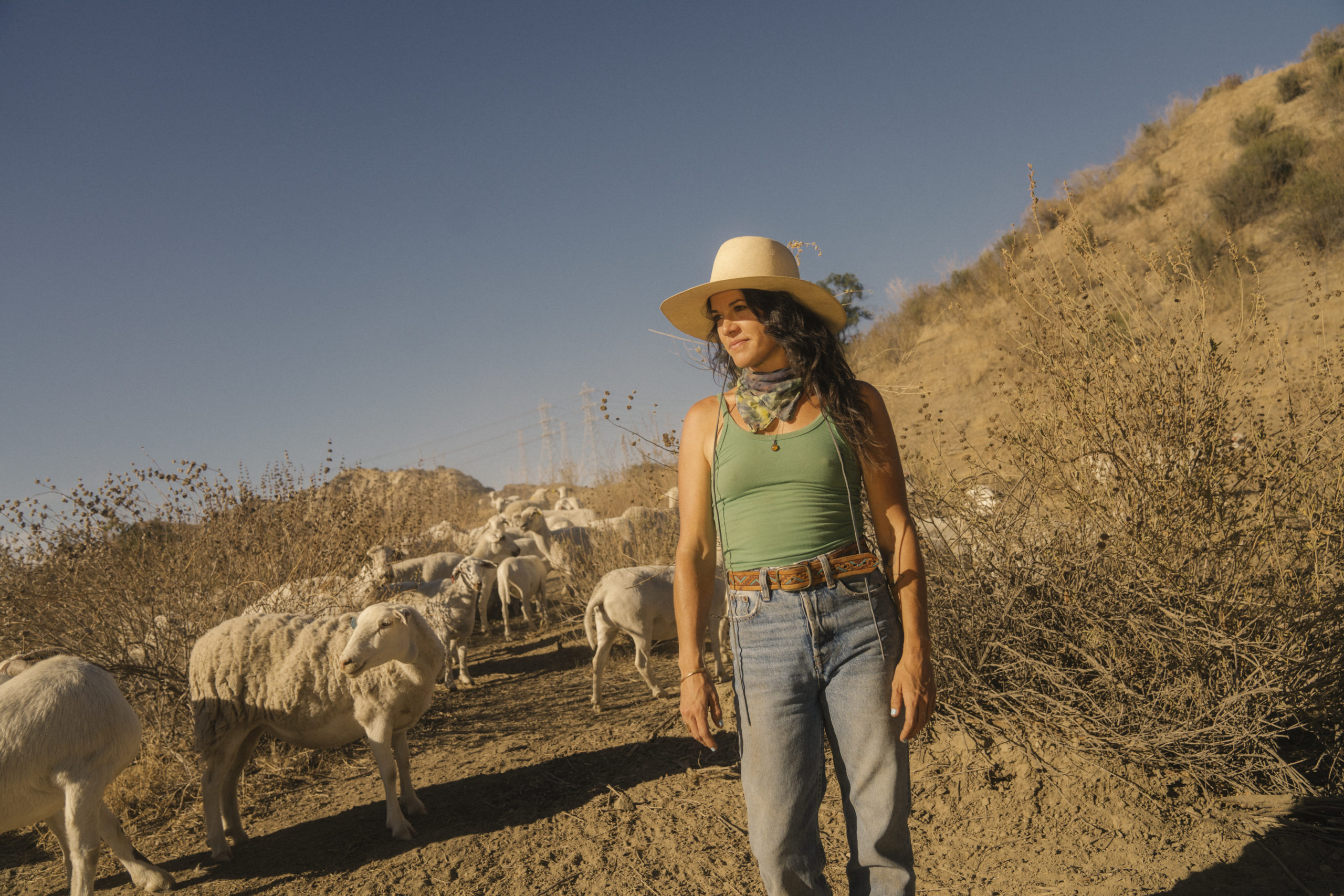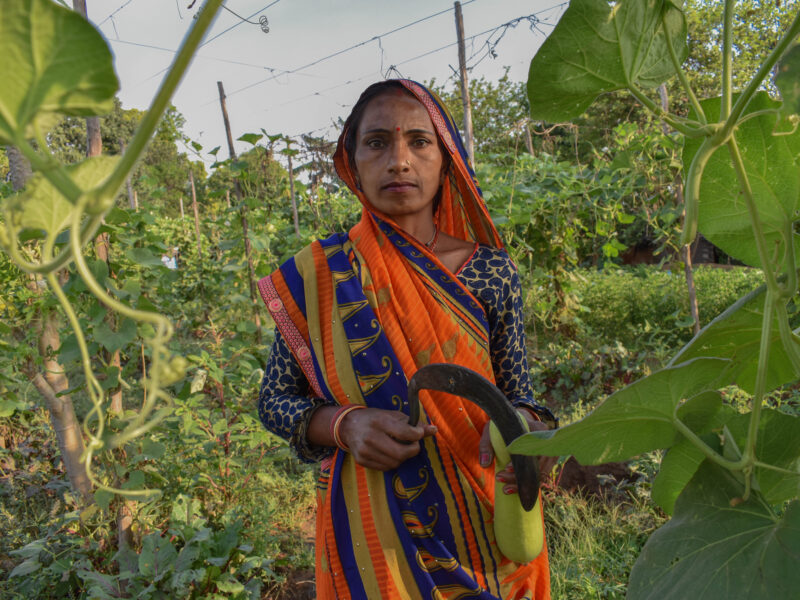Meet Cole Bush, the shepherdess battling fire season with goats and sheep.
One morning last summer, Cole Bush was high up on a ridge in North Los Angeles County, shepherding her “flerd”—a mixed flock of sheep and herd of goat—from one paddock to another. Normally, this maneuver was routine; but something was wrong. When she turned around, in the distance far below, she spotted a hundred of her goats and sheep: They had slipped off into a high school parking lot and were eating the median. People were already gathering around them. Bush and her team ran down the steep hillside as quickly as they could and found a football coach surveying the scene. She began to explain what was going on: Her animals, now munching away on tufts of grass, weren’t just a prank gone awry. They were there to protect them from fire.
This answer likely surprised him, but Bush—who goes by BCB—explained that the animals were on the clock. Based out of Ojai Valley, in Ventura County, California, Bush’s business, Shepherdess Land and Livestock Co., is a for-hire grazing outfit that focuses on fire prevention and vegetation management. The work they do is tantamount to creating protective force fields; shepherding the flerd to eat brush, weeds, invasive plants—would-be fuel—so that fires won’t move as quickly or get as hot. The grazing is not to eradicate fires, but to ensure they’ll be smaller, more manageable, and to create defensible space.

Of course, the animals have no idea they’re rushing against time to prevent the destruction of property, livelihoods, and a potential great extinction. They’re just animals doing animal things; curious, hungry, and content to roam. They have good days and bad depending on the elements; on a hot day they might move more slowly. If there are interesting landscaped yards—or football fields—nearby, they might wander over to get a taste.
Still, they’re highly effective. As they roam, their hooves aerate the soil, making it healthier. They digest plants and turn them into food for the soil when they shit. “Their bodies know so much,” says Bush. From the womb, their gut biomes are prepared as their mothers introduce them to the local weeds and brush. From birth, they begin learning what they need and how to exist with the land; and when they stray, their shepherdess guides them home.
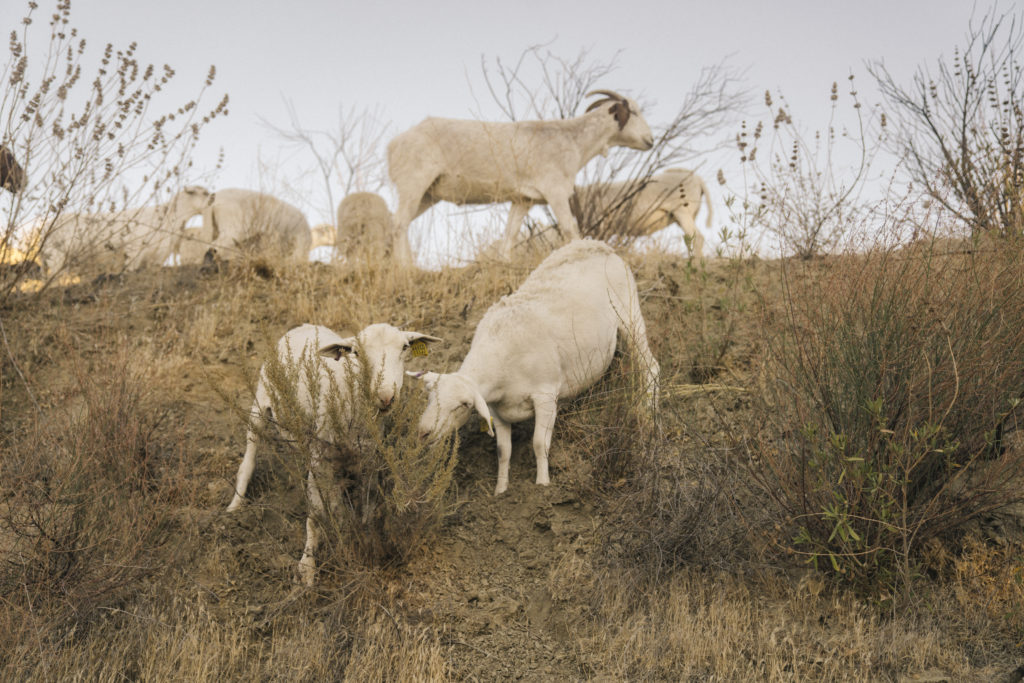
If it seems like an underreaction to employ goats and sheep to combat an ever-expanding fire season, that’s part of the point of Bush’s project. “We have a culture of fear around fire,” she says, when we need to feel empowered against it. And to feel powerful against an element that turns us into shut-ins, that paints the sky otherworldly colors and sends residents fleeing from their homes every year, Bush says, requires us to first re-examine our relationship to the land it ravages.
“A lot of our work is this idea of bridging, of the translation piece,” she says. “We’re at war with the earth when in fact we need to see that we’re a part of it.”
~
Bush grew up in San Diego, the chaparral region of California, a fire-prone ecosystem. In middle school, her family moved to a house in Elfin Forest, just north of the city, which they could afford because the forest itself had burned down.

In the barn, a young Bush could see the smoke stains on the stucco walls. “We lived in the shadows of the aftermath of fire,” she remembers. Even then she understood on some level, despite the ash and the charred remnants of trees, that fire was not a combative element. “How [the ecosystem] has evolved with fire is so important. But the way that we have not actively stewarded or tended to our landscapes has created the devastation of mega wildfires.”
It would be a long road before Bush would realize her place was among the “flerd.” Raised in the Church of Latter-Day Saints, she knew two things by the time she was 20: that she was queer, and that she had to leave the church. Still, she remembers an idyllic childhood. Her family would cross the border to Rosarito almost every Sunday, driving workers from her dad’s LED business home. In Mexico, they’d join them for community dinners, where Bush remembers not wanting to go back to the suburbs, back to the States, where neighbors lived close, but seemed to be strangers to one another.
As Bush began breaking away from the church, she became increasingly hungry for understanding what made groups—and cultures—cohere and thrive. She thought that built environments were the answer. She’d dropped out of college, but returned to school to take classes on the history of civilizations. “All of them c[a]me down to the same demise,” she learned, “which is lack of resources or depletion of resources.” Pivoting her focus, Bush began to gravitate towards agroecology and environmental studies. It was there that she learned about what would later be called regenerative agriculture. Now it’s a buzzword—a shell for many things, often conflated with sustainability—but for Bush, regeneration was tied to the idea of “ancient futures,” of taking lessons and traditions from the past and adapting them to a future sorely in need of change.
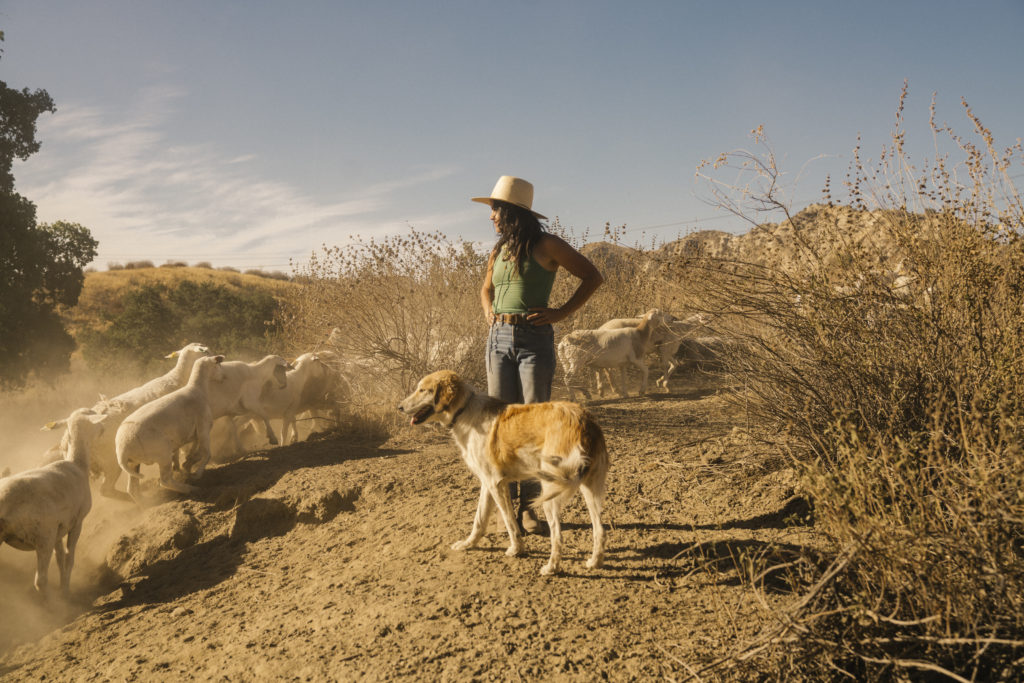
And then she met Becky, a border collie who worked at Star Creek Ranch in Santa Cruz County, California. When Becky’s owner had to leave town, Bush adopted her and started working at the ranch alongside her, taking photos of the goats and sheep Becky herded. She began to see the animals’ personalities emerge. The goats were the “bad kids on the block,” and the sheep did, indeed, prefer to stick together. They were also surprisingly sweet with their young. Bush was hooked. The ranch opened a grazing business, called Star Creek Land Stewards, and when it landed its first big contract in 2012, Bush became the project manager. She was 27, in charge of organizing thousands of acres of prescribed grazing.
When the owner wanted to retire and sell the ranch in 2014, Bush helped track down a family that traced its lineage back to European Basque shepherds to buy and run the business. Through them, Bush was helping to reinvigorate a shepherding tradition that had waned after WWII, when demand for wool and mutton fell, followed by another decline in the ’60s, as synthetic fibers continued to gain in popularity. In addition to grazing, she started selling high-end hides—repurposing waste from the lamb industry—and began calling herself “a modern-day urban shepherdess.” She had found her calling.
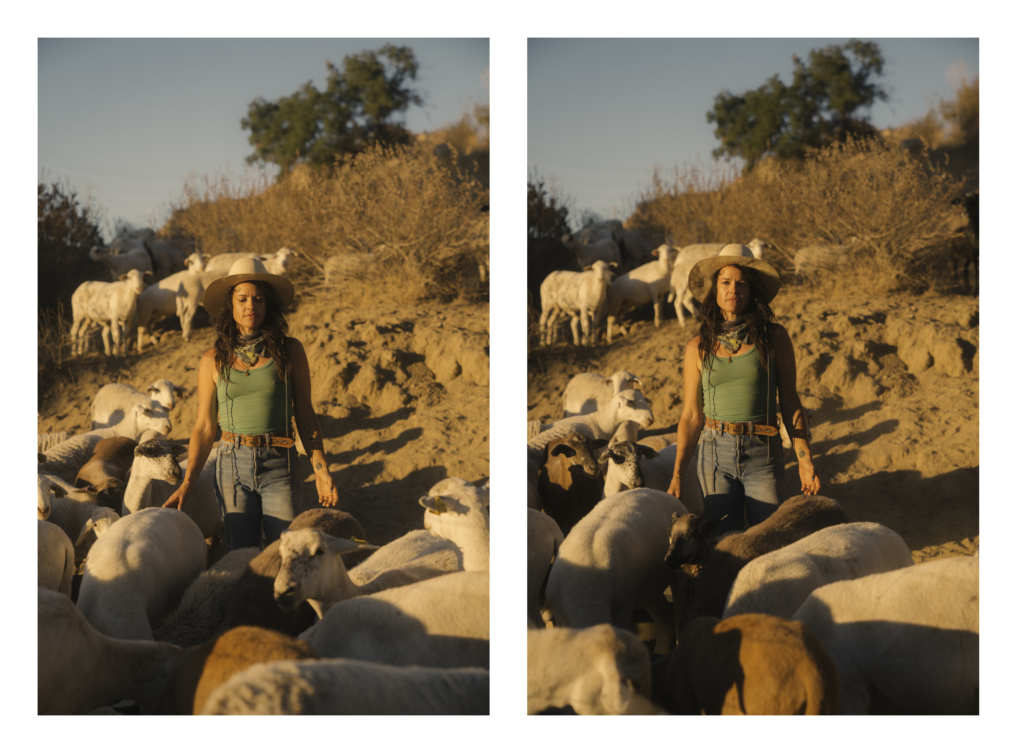
Soon, she took off for Spain and France, where she studied not just shepherding but also the systems that allow young people to become shepherds. She was following in the footsteps of a tradition that had existed long before her; exploring what makes a shepherd a shepherd, and what might attract more people to the work—questions posed by respected researchers like Fred Provenza and Michel Meuret in books she’d studied. She was now certain that she had “sheep and goat in her blood,” and dreamed of a grazing school in California. She created a curriculum and developed a project called The Grazing School of the West despite having no students yet. Someday, she thought, it would be a place where people could work the land with each other, with a community supporting them as they experimented with a vocation that might end up being a life calling, like it was for her. “This ancient vocation somehow persists in contemporary times and will always be a part of humanity,” explains Bush. “Domesticating animals and agriculture is what allowed us to grow as a species on Earth.”
Now, she hoped those same tools might be used to help the species survive.
~
In 2017, the Thomas Fire raged through Southern California, burning nearly two-hundred and ninety-thousand acres of land over the course of a month. The city of Ojai was surrounded by flames, and though they never fully breached its perimeter, they destroyed more than seven-hundred and fifty homes in nearby Ventura and Santa Barbara counties. At the time, it was the largest fire in California’s history—and for Bush, it served as a wake up call.
Ojai Valley was a place Bush felt close to; she’d visited often and found herself more connected to nature there. She saw, too, that Southern California was in need of a new approach to fire, one that would not perpetuate the tropes of fear and flight, losing and winning, burning and rebuilding. It needed something different, something radical but not experimental, something reliable and time-tested. It needed goats, sheep, and shepherds. So, when she opened up her own prescribed grazing outfit in 2020—Shepherdess Land and Livestock Co.—she did it in Ojai.

At the time, she knew she was choosing to “be a part of this crazy capitalist system, go out and make money and create jobs for people so that I can pay them.” It was a risky path, but the goal was always to use the grazing company not only for fire prevention but also to subsidize training for a new generation of shepherds. Bush thinks that there is a boom coming in the U.S.; a wave of people who will be eager to dedicate themselves to the land. But they won’t have the same social safety nets, like shepherds in Europe, to help them as they learn. They’ll need to get paid. Last year, The Grazing School of the West welcomed its first cohort of eight trainees. This year Bush is training six, paying them a livable wage. She hopes to continue to expand the program to include twelve shepherds each year.

When trainees see the flerd for the first time, there is a high-frequency buzz of excitement in the air. When the first goat or sheep wanders off, they panic, thinking they’ll lose the animal. And at some point, the weight of being responsible for so many lives washes over them and the true nature of the work becomes clear. In her letter preparing interested would-be shepherds for the job, Bush warns that the work “will be the HARDEST work you could possibly imagine.” It’s mostly fence-building in one-hundred-degree heat and practicing patience with people who sometimes don’t know the difference between a sheep and a goat. Since it’s rare to be grazing far from private property, Bush has to invest in liability insurance for her flerd—in case they destroy landscaping or wander into the wrong yard or, in the worst case scenario, onto a highway. Not everyone is cut out for those realities, which Bush admits don’t appear on her social media, and leads to a swath of applicants who have never done manual labor but have done a lot of Instagramming. “I made it look way too beautiful and cool,” she says. “And I’m looking at some applicants, and I’m just like, Oh, no, this is an issue.”
Still, Bush is also turning away applicants who would be good fits. “[Prescribed grazing is] a huge burgeoning industry, and the biggest bottleneck is a skilled and trained workforce,” she says. She doesn’t have the resources to expand her program, and no one else seems to either. In Bush’s experience, young folks do want to become shepherds. But she’s left wondering, “What is the barrier to getting these people trained for more businesses and more hands on the ground?” The David vs. Goliath framing, made so common by climate change, leaving smaller actors feeling impotent, weighs on her. “I would say pretty regularly I am overwhelmed with emotion because I just wish I could do more faster,” she says. Twelve new shepherds a year is not going to solve the chaos that’s already happening. And it’s frustrating when there are plenty more than twelve people who want to and could become shepherds.

Lately, with a team she can trust on the ground, Bush has been taking more time away from the day-to-day operations and focusing on education. Usually, and especially with fire, we wait for a fight to make itself plain and then send out the troops, sparing no expense. But there is another way—and Bush is trying to build bridges to decision makers who can help push structural change. In order to scale ideas, it’s all about getting funds from the state level to specific, grassroots level grazing projects, she says. One of her most radical ideas would be to bring goats into prisons, instead of sending inmates to go out and fight fires, a dangerous and grueling task. “Why don’t we train inmates to learn how to manage and work with livestock?” Bush asks. “To do the same work that we’re doing and also have such incredible healing components with working with animals?” These are the types of ideas she hopes to bring to the table; to prioritize prevention over fear and connection over combativeness.
The numbers don’t seem to be in Bush’s favor, nor does time, as fire season continues to expand; 2.5 million acres of land in California burned in 2021 alone. But that’s the thing about a calling: Once you answer it you have to find your way forward. If a few meetings with assembly members go well, if a few more shepherds learn quickly, then Bush might be able to shift just a few more people’s perception of fire, of animals, of the land. In turn, the path might open a bit wider for the boom of ecological doctors and modern-day shepherds that she sees coming.
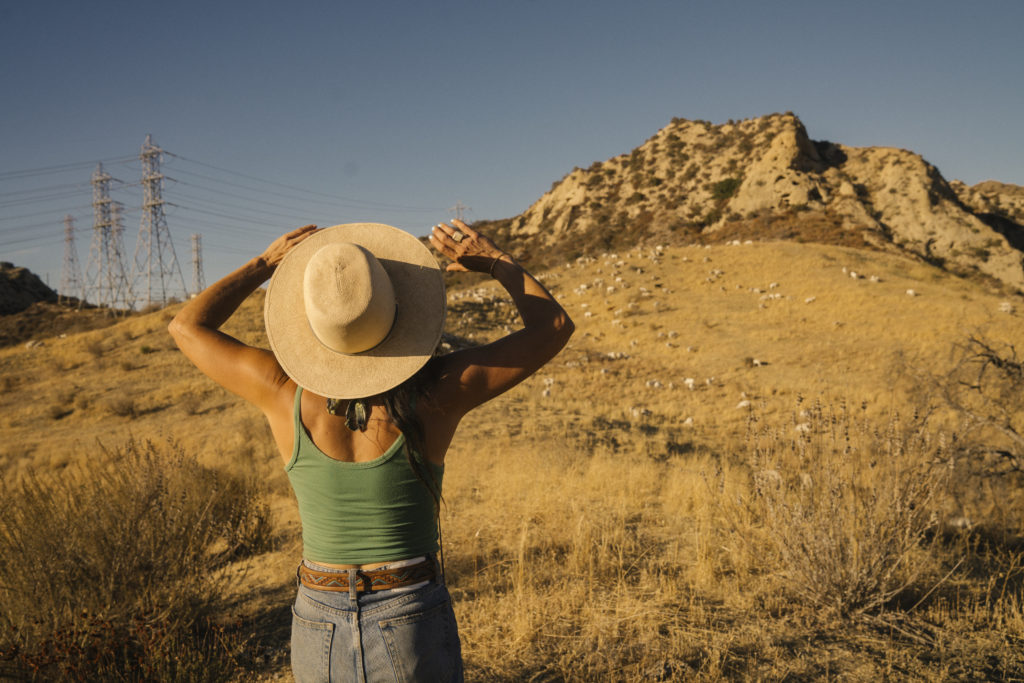
With every successful connection made and bridge built, Bush stays hopeful. In the high school parking lot, as she handed the football coach her card and talked to the observers, she quickly diffused a potentially fraught situation. By the end of the day the onlookers were spreading the word that the “flerd” was in the neighborhood with a purpose, and that if anyone found animals suddenly roaming alongside them, they didn’t have to panic; they were exactly where they needed to be.
In the end, Bush considers herself a herder of humans as well as animals. And if nothing else, humans need to figure out how to give ourselves more time, so we might have more chances to adjust. As she writes in her closing line of the letter she sends to prospective shepherds, “It’s a daunting world in society these days and the Earth is throwing out all kinds of loud cries for humanity to get a grip. We can do our part even if small and maybe we can herd on together for some time.”

Additional fact checking by Elizabeth Moss.
~
*The Footnotes
Editor’s Note: At The Conversationalist, we understand that no story exists in a vacuum, and every story is built on the work of others before us, whether in ways big or small. We are likewise dedicated to spotlighting the voices of those who have been or continue to be oppressed, disregarded, and/or otherwise silenced, in an effort to reverse centuries of often intentional erasure. Because of this, we have opted to include “footnotes” on certain stories to give readers additional context and reading material where it feels relevant and beneficial.
- Additional Reading: The Art & Science of Shepherding, edited by Michel Meuret and Fred Provenza
